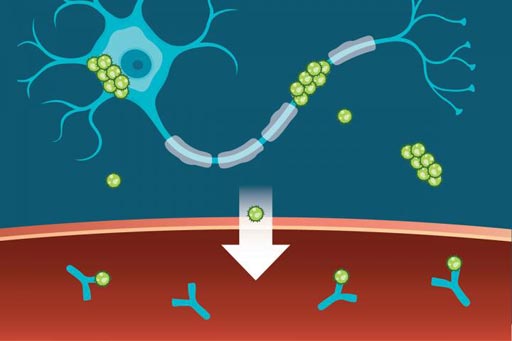Anti-Tau Antibody May Facilitate New Diagnostic Procedures
By LabMedica International staff writers
Posted on 01 May 2017
The novel use of an antibody that specifically recognizes the tau protein may pave the way for development of a method to quantitate this protein, which has been linked to several debilitating neurological disorders, in samples of blood or plasma.Posted on 01 May 2017
Tauopathies are a group of disorders in which the cytosolic protein tau aggregates and accumulates in cells within the brain, resulting in neurodegeneration. Up to now detection of tau in the blood or plasma has been hindered by the very short half-life of the protein in circulation. In fact, investigators at the Washington University School of Medicine recently found that in mice plasma, tau had a short half-life of only eight minutes.

Image: Tangles of the brain protein tau are associated with neurological diseases such as Alzheimer\'s. Specific antibodies can capture tau in the blood, facilitating efforts to measure levels of the damaging protein and paving the way toward a noninvasive test for tau (Photo courtesy of Sara Moser).
In order to extend the amount of time tau could remain in circulation, the investigators administered an anti-tau antibody to human patients with tauopathy and to mice expressing human tau in the central nervous system. They reported in the April 19, 2017, online edition of the journal Science Translational Medicine that following this treatment the half-life of tau in circulation increased to more than three hours.
Injection of anti-tau antibody into tau transgenic mice that had decreased brain soluble tau and interstitial fluid tau resulted in an increase in plasma tau, but this increase was less than that observed in tau transgenic mice without these brain changes. Tau transgenic mice subjected to acute neuronal injury using 3-nitropropionic acid showed increased interstitial fluid tau and plasma tau. These data suggested that peripheral administration of an anti-tau antibody resulted in increased plasma tau, which correlated with the concentration of extracellular and soluble tau in the brain.
"We showed that you can measure tau in the blood, and it provides insight into the status of tau in the fluid surrounding cells in brain," said senior author Dr. David Holtzman, professor of neurology at Washington University School of Medicine. "We have no test that accurately reflects the status of tau in the brain that is quick and easy for patients. There are brain scans to measure tau tangles, but they are not approved for use with patients yet. Tau levels can be measured in the cerebrospinal fluid that surrounds the brain and spinal cord, but in order to get to that fluid, you have to do a spinal tap, which is invasive."
The anti-tau antibody used in this study has been licensed to C2N Diagnostics, which is collaborating with the pharmaceutical company AbbVie in developing the technology.













